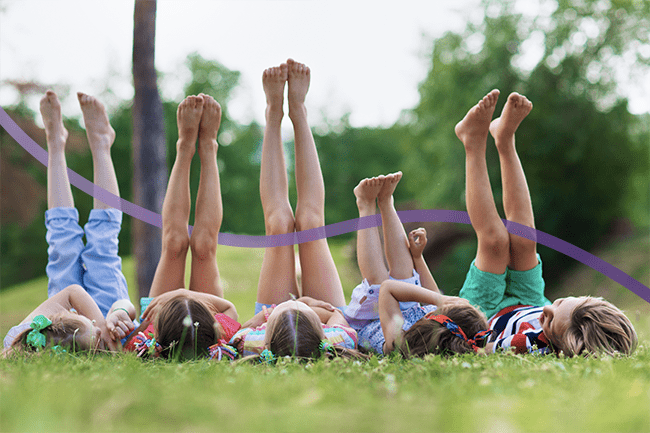

As a parent, seeing your child in any sort of pain can be tough. Especially if they can’t communicate exactly what’s wrong, or
it’s a problem that’s not going away. This is often the case with issues relating to the feet - they can affect your
child’s everyday activity levels and cause pain just from walking. That’s where we come in - helping you find the cause of your
child’s pain and solutions to try and help fix it. In this article, we’ll cover how children’s feet differ from adults,
signs to look out for, how orthotics can help and how to take the first steps.
How do children’s feet differ from adults?
The most obvious answer is that children’s feet are still growing and developing. Whilst going through this phase, the skeleton has not fully developed and hardened. This means that abnormalities such as flat feet are common, as well as Sever’s disease, which is pain at the heel growth plate. Without the hardened, tough skeleton and fully realised foot structure, children are more vulnerable to experiencing pain.
However, as most foot issues in children are growth-related, the pain felt and treatment for them is usually short. As a result, podiatrists must review and assess treatment more regularly in children as a growth spurt could fix or worsen a particular issue. This is in contrast to adults where orthotics might be prescribed for years on end as their foot issue is unlikely to change or shift.
Signs your child might need orthotics
Children, especially younger ones, are not always the best at clearly communicating how they’re feeling. So here are some behaviours or things that your child might say that may indicate they need custom orthotics.
Verbal cues
Non-verbal cues
Hereditary
How can orthotics help?
The two key issues that orthotics can help children with are flat feet and calcaneal apophysitis (or Sever’s disease). So, let’s dive into both of them and explore how orthotics can help.
Flat or ‘flexible’ feet
This is most common in younger children and occurs when the foot arch has not fully developed. You’ll see that the arch disappears when they stand up. Flat feet are usually something that children grow out of before age 5, but before that happens, they can cause some pain. It feels like a cramping sensation in the legs and feet when your child walks, causing them to avoid standing up or walking. Orthotics can help to emulate the arch and alleviate strain on the surrounding soft tissue muscles. With the correct orthotics, your child will not only experience less pain, but they will also reduce the feeling of cramping and ensure that your child continues physical activity without discomfort.
Sever's Disease
Sever's Disease directly affects the heel but can cause pain in the ankle and up the leg too. The disease is caused by repetitive strain on the growth plate of a not yet fully developed heel, which is commonly active in 8-14 year olds. It essentially reacts to this strain with inflammation, causing cramping and pain in and around the heel. The pain will become even more pronounced with high impact movements such as running or jumping. Orthotics can be part of the solution to help reduce pain, paired with strengthening exercises. In extreme cases, taking a rest from high impact activities is the least desirable option as developing kids need to play and be active as it is an important part of learning and skill development, and their overall health and well-being. Orthotics will help to support the heel throughout their activity, so they can recover quickly to remain active. The exercises complement the orthotics by strengthening the supporting soft tissue thus lessening the impact on the heel to support your child running or jumping.
Lateral Ankle Sprains
Lateral ankle sprains often occur when the foot suddenly rolls outwards or twists, forcing the ankle out of its normal position. These ligaments can only stretch so far before they tear. Rehabilitation of this condition does not usually involve orthotics, however, prevention of this condition from occurring or becoming recurrent is where orthotics help because orthotics have been shown to improve proprioception and balance. Proprioception is the information that is sent to our brain on where we are in space and time. Orthotics influence this by increasing the amount of data sent to the brain so our brain can make a better decision on how to stabilise our foot when it is tested on uneven surfaces or changing directly unexpectedly. As the saying goes, prevention is better than a cure.
Where to go for orthotics?
Now you know how orthotics could help your child’s pain, what are the next steps? First off, you can visit your general practitioner to get a referral for a podiatrist. Alternatively, you can seek assistance privately with a trusted podiatrist, just like us at The Feet People, at our Brisbane CBD or Newmarket clinic.
We hope you’ve found this blog useful, and it helped you to understand how to potentially cure your child’s foot pain. For
more information from expert podiatrists, check out our other articles here. Or, if you would like to
come in for an appointment, book in today.
Book your appointment with our podiatry team online
here
or call us on (07) 3356 3579.
| Monday | 7:30am - 6:30pm |
| Tuesday | 7:30am - 6:00pm |
| Wednesday | 7:30am - 6:30pm |
| Thursday |
7:30am - 6:00pm |
| Friday | CLOSED |
| Saturday | CLOSED |
| Sunday | CLOSED |
Ground Floor, 344 Queen Street,
Brisbane City QLD 4000
| Monday | 7:30am - 6:00pm |
| Tuesday | 7:30am - 6:00pm |
| Wednesday | 7:30am - 6:00pm |
| Thursday |
7:30am - 6:30pm |
| Friday | 7:30am - 5:30pm |
| Saturday | 7:30am - 4:30pm |
| Sunday | CLOSED |
Newmarket Village, 114/400 Newmarket Rd, Newmarket QLD 4051